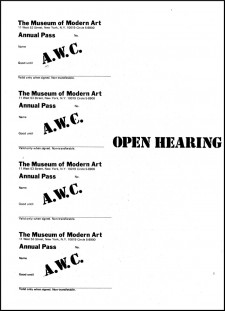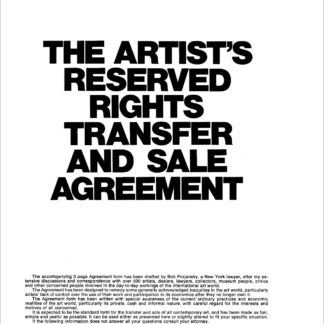Description
Open Hearing is a monumental collection of statements originally published in the wake of the first public meeting of the Art Workers’ Coalition (AWC), at the School of Visual Arts in New York on April 10, 1969. The meeting was billed as “an open public hearing […] regarding museum reform” and the establishment of a program for the AWC, in which any and all art workers were invited to “testify.” It was a consummation of the group’s inception that January, in which the urgency of its foundational concerns and its potency as a rallying point for diverse critical voices were made manifest.
Open Hearing is both a document and an extension of that watershed event, consisting of texts collected from a number of the participants as well as transcriptions of the proceedings. The publication was to “be freely circulated and is intended to form a solid basis for a permanent organization designed to represent the best interests of all art workers.” Its topics, as broadly outlined in the publication itself, range from black and Puerto Rican artists’ rights, to the reform and renunciation of “museums and art institutions,” to the structure of the AWC itself. Open Hearing preserves a sweeping, manifold collective declamation, whose tangible resonance is a testament to its own continuing importance.
Participating artists are Carl Andre, Architects’ Resistance, Robert Barry, Gregory Battcock, Jon Bauch, Ernst Benkert, Don Bernshouse, Gloria Greenberg Bressler, Selma Brody, Bruce Brown, Bob Carter, Frederick Castle, Rosemarie Castoro, Michael Chapman, Iris Crump, John Denmark, Joseph Di Donato, Mark Di Suvero, George Dworzan, Farman, Hollis Frampton, Dan Graham, Chuck Ginnever, Bill Gordy, Alex Gross, Hans Haacke, Clarence Hagin, Harvey, Gerry Herman, Frank Hewitt, D. Holmes, Robert Huot, Ken Jacobs, Joseph Kosuth, David Lee, Naomi Levine, Sol LeWitt, Lucy Lippard, Tom Lloyd, Lee Lozano, Len Lye, James McDonald, Edwin Mieczkowski, Minority A, Vernita Nemec, Barnett Newman, John Perreault, Stephen Phillips, Lil Picard, Peter Pinchbeck, Joanna Pousette-Dart, Barbara Reise, Faith Ringgold, Steve Rosenthal, Theresa Schwarz, Seth Siegelaub, Gary Smith, Michael Snow, Anita Steckel, Carl Strueckland, Gene Swenson, Julius Tobias, Jean Toche, Ruth Vollmer, Iain Whitecross, Jay Wholly, Ann Wilson, and Wilbur Woods.
Founded in January 1969, the Art Workers’ Coalition was a loose association of artists, writers, and cultural workers organized around shared commitments to social action and the reform and revaluation of art institutions. The immediate catalyst for the group’s formation was the artist Takis’ withdrawal of his work from an exhibition at the Museum of Modern Art (MoMA), in protest of the lack of control afforded artists in the exhibition of their artworks which had been purchased by the museum. The group’s efforts to establish an open dialogue with MoMA were rebuffed, and the museum refused their request to host a public discussion on its responsibilities to artists and the public. In response, the AWC hosted an “open hearing” at the School of Visual Arts on April, 10, 1969, in which “[e]very art worker” was invited “to make a statement of his attitudes and complaints about all art institutions and conditions.”
The widely attended open hearing was a watershed event for the burgeoning group, facilitating the expansion of its aims and premises to be more broadly inclusive. Throughout the early part of 1969, the AWC snowballed into an umbrella organization, its polemical thrust reinforced and widened through the incorporation of diverse sympathetic causes. The group was bent on serving “the best interest of all art workers,” and through their protests and publications—Open Hearing, which both documents and effectively extends the titular event of April, 10, 1969; and Documents 1, an account of the group’s history and its aims through correspondence, press, and ephemera— aired a wide-ranging critique of the art world and Vietnam-era society at large. Reluctant from the start to adopt any kind of centralized, hierarchical organization, the AWC splintered in 1971, giving way to such groups as Art Strike, Guerilla Art Action Group, and Women Artists in Revolution.
1969 / 2008



